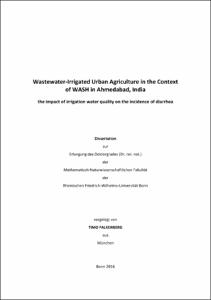Falkenberg, Timo: Wastewater-Irrigated Urban Agriculture in the Context of WASH in Ahmedabad, India : the impact of irrigation water quality on the incidence of diarrhea. - Bonn, 2017. - Dissertation, Rheinische Friedrich-Wilhelms-Universität Bonn.
Online-Ausgabe in bonndoc: https://nbn-resolving.org/urn:nbn:de:hbz:5n-46566
Online-Ausgabe in bonndoc: https://nbn-resolving.org/urn:nbn:de:hbz:5n-46566
@phdthesis{handle:20.500.11811/7140,
urn: https://nbn-resolving.org/urn:nbn:de:hbz:5n-46566,
author = {{Timo Falkenberg}},
title = {Wastewater-Irrigated Urban Agriculture in the Context of WASH in Ahmedabad, India : the impact of irrigation water quality on the incidence of diarrhea},
school = {Rheinische Friedrich-Wilhelms-Universität Bonn},
year = 2017,
month = mar,
note = {Introduction: Urban agriculture is a low-input system, where the inputs of production are drawn from the urban wastestream. The use of wastewater is beneficial, providing perennial irrigation water and reducing the need for artificial fertilizers. Yet the unplanned reuse of wastewater poses health risks to farmers and consumers.
Methods: The research was conducted in four farming communities from August 2013 to August 2014. The study consists of three methodological streams: epidemiological, microbiological and cross-sectional. The epidemiological methods were applied longitudinally and include a health diary and the hygiene index. Exposure is assessed in the microbiological stream through the quantification of E. coli in irrigation and drinking water. The cross-sectional methods include three surveys (baseline, hygiene and farm) and anthropometric measurements of children under twelve.
Results: Both surface and wastewater do not meet the standard for restricted irrigation (9.28x10^5 and 4.02x109 E. coli/100 ml, respectively), while groundwater samples from the control area are suitable for unrestricted irrigation (411 E. coli/100 ml). The exposure and control group experience 13.3 and 7.9 episodes per 1,000 person-weeks, respectively. Irrigation water quality has an adverse effect on the degree of in-household water contamination (ATE: 18.15) and hygiene (ATE: -2.05). The preventive effects of sanitation only fully manifest if large proportions of the community have access. The ATE of wastewater irrigation (2.73) is similar to that of PoU water (2.54).
Conclusion: Wastewater irrigation is an integral part of the WASH nexus following the same transmission routes as open defecation, influencing drinking water quality and hygiene and thus adversely impacting diarrhea incidence. Mitigating the health risks of wastewater irrigation needs to be part of diarrhea prevention strategies, as pathogens are introduced into the farm environment and transferred to the community potentially undermining the efforts of WASH interventions.},
url = {https://hdl.handle.net/20.500.11811/7140}
}
urn: https://nbn-resolving.org/urn:nbn:de:hbz:5n-46566,
author = {{Timo Falkenberg}},
title = {Wastewater-Irrigated Urban Agriculture in the Context of WASH in Ahmedabad, India : the impact of irrigation water quality on the incidence of diarrhea},
school = {Rheinische Friedrich-Wilhelms-Universität Bonn},
year = 2017,
month = mar,
note = {Introduction: Urban agriculture is a low-input system, where the inputs of production are drawn from the urban wastestream. The use of wastewater is beneficial, providing perennial irrigation water and reducing the need for artificial fertilizers. Yet the unplanned reuse of wastewater poses health risks to farmers and consumers.
Methods: The research was conducted in four farming communities from August 2013 to August 2014. The study consists of three methodological streams: epidemiological, microbiological and cross-sectional. The epidemiological methods were applied longitudinally and include a health diary and the hygiene index. Exposure is assessed in the microbiological stream through the quantification of E. coli in irrigation and drinking water. The cross-sectional methods include three surveys (baseline, hygiene and farm) and anthropometric measurements of children under twelve.
Results: Both surface and wastewater do not meet the standard for restricted irrigation (9.28x10^5 and 4.02x109 E. coli/100 ml, respectively), while groundwater samples from the control area are suitable for unrestricted irrigation (411 E. coli/100 ml). The exposure and control group experience 13.3 and 7.9 episodes per 1,000 person-weeks, respectively. Irrigation water quality has an adverse effect on the degree of in-household water contamination (ATE: 18.15) and hygiene (ATE: -2.05). The preventive effects of sanitation only fully manifest if large proportions of the community have access. The ATE of wastewater irrigation (2.73) is similar to that of PoU water (2.54).
Conclusion: Wastewater irrigation is an integral part of the WASH nexus following the same transmission routes as open defecation, influencing drinking water quality and hygiene and thus adversely impacting diarrhea incidence. Mitigating the health risks of wastewater irrigation needs to be part of diarrhea prevention strategies, as pathogens are introduced into the farm environment and transferred to the community potentially undermining the efforts of WASH interventions.},
url = {https://hdl.handle.net/20.500.11811/7140}
}






